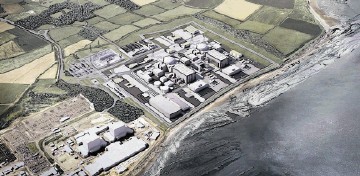
Builders of the UK’s first nuclear plant in two decades are about to take a vital component and break it.
The 110-tonne spherical steel lid was destined to sit atop EDF Energy’s new reactor at the Hinkley Point site in Somerset.
Instead, it will be sacrificed to test the strength of a part already welded in place at similar atomic projects in France and China.
The tests are essential after regulators found potential weaknesses in the steel used to contain radiation.
The results may derail countries’ nuclear programmes that are relying on EPRs (European pressurised reactors). They also threaten a generation of atomic plants that developer Areva has billed as the world’s safest.
Pierre-Franck Chevet, head of the safety regulator that raised the alarm, said: “We are the nuclear police. I like the police, but not everyone does.”
In the UK, two of Areva’s reactors costing an estimated £24.5billion are key to government plans to meet future gaps in base-load power and keep the lights on.
Hinkley Point is scheduled to start up in 2023 and operate for 60 years, delivering 7% of UK electricity generation.
As the country considers final approval of the proposals, the safety setbacks will only add to concerns as two of the EPR reactors being built so far in France and Finland are already years behind schedule and billions of pounds over budget.
The examination of “anomalies” found in steel in the EPR vessel is also a test of the credibility of a French nuclear programme led by Electricite de France that seeks to export technology to the UK, China and possibly the Middle East.
The issues were found in the 16ft head and base of the container for the reactor core built at Areva’s Creusot Forge in eastern France.
If further tests prove they aren’t strong enough, the equipment can’t be used, Mr Chevet, president of France’s Autorite de Surete Nucleaire, said.
Removing those parts from the development sites where they’re already welded into place in Normandy, France, and Taishan, China, would at the least add to costs and delays.
Credit ratings agency Standard & Poor’s said in a credit note: “If testing results in component replacement, this would be very expensive and time consuming in our view – especially if it implies similar actions for other projects,”
Areva is confident of demonstrating the safety of the vessel and its components, while lessons from the Normandy development will be used in manufacturing for the Hinkley Point reactor, a spokesman said.
EDF chief executive Jean-Bernard Levy told shareholders last month the utility would demonstrate the French plant’s EPR components were safe.
Both Areva and EDF say their programme’s latest difficulties follow changes in safety rules introduced in 2005 that weren’t immediately set out in detail.
The regulator says problems were found because of extra testing and it has asked Areva to review the manufacturing methods it has used over the past decade.
Mr Chevet said: “The new rules meant more verification tests had to be carried out and these allowed the anomalies to come to light.
“It’s not the level of standards that changed but rather because there were more tests, we found things. If we had found the same anomaly back then, we would have reacted in the same way.”
Recommended for you
